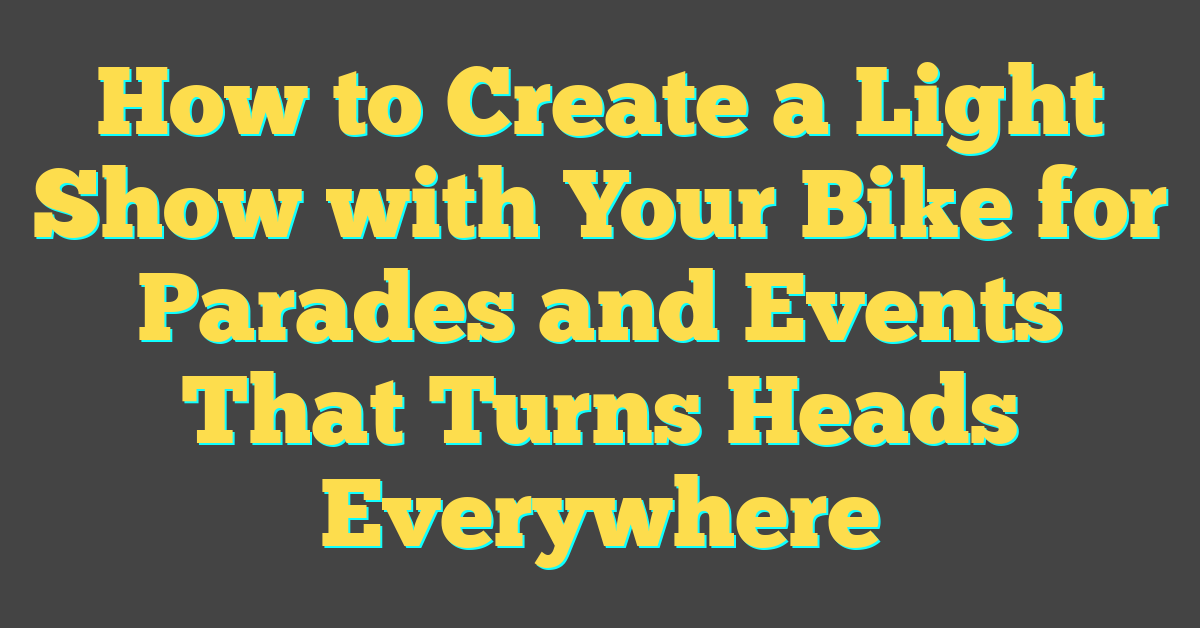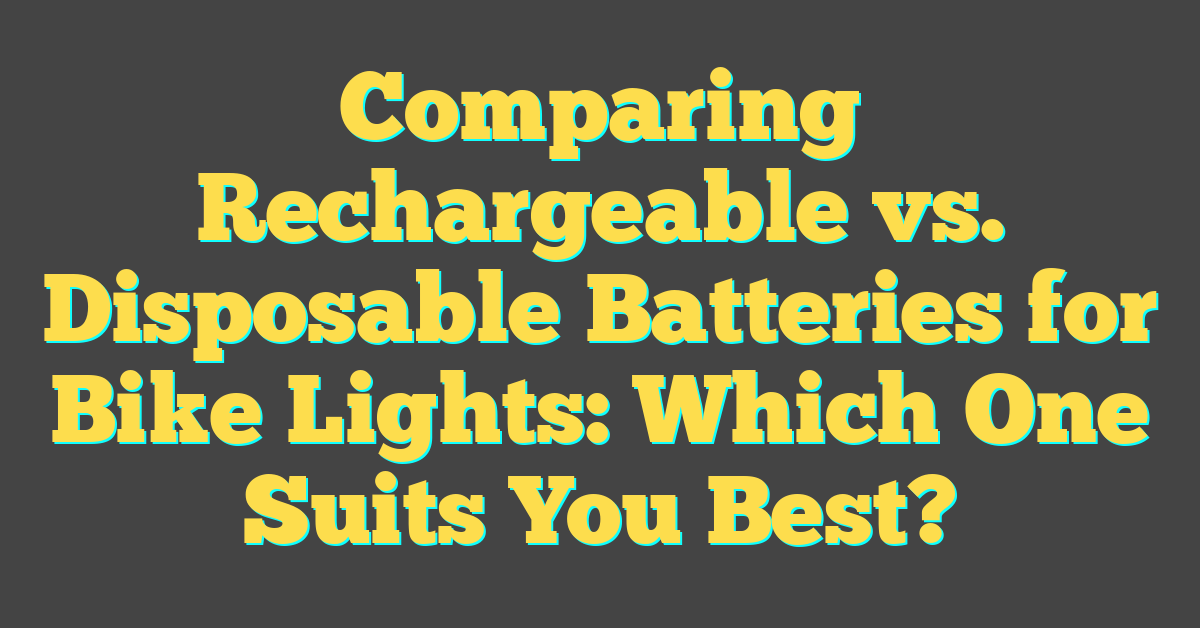There’s something magical about a bike decked out in colorful lights, gliding through a parade or event. It’s not just about standing out—it’s about creating a spectacle that turns heads and spreads joy. I’ve always loved the way a well-lit bike can transform an ordinary ride into a dazzling experience.

If you’ve ever wanted to bring that kind of energy to your own bike, you’re in the right place. It’s easier than you think to design a light display that’s both eye-catching and safe. Whether it’s for a holiday parade or a fun community event, I’ll walk you through the basics to make your bike the star of the show.
Why Create a Light Show for Your Bike?
A light show on your bike adds a unique, dazzling touch to parades and events. I’ve seen how a well-lit bike grabs attention immediately, drawing smiles and cheers from the crowd. The interplay of colors and motion creates a captivating spectacle, turning your ride into the centerpiece of any gathering.
Visibility and safety are also key benefits. Bright lights make you stand out, especially in low-light situations, ensuring everyone can see you. For instance, multi-colored LEDs or neon strips increase your visibility without compromising the artistic vibe of your design. It’s a practical feature that blends seamlessly with creativity.
Light displays showcase personality and creativity. I enjoy customizing light patterns, syncing them with themes like holidays, patriotic events, or personal motifs. For example, red and green colors suit Christmas parades, while blues and whites shine for winter events. The flexibility lets you align your design with the occasion.
Adding a light show also inspires community engagement. I’ve found that illuminated bikes often start conversations, spark ideas, and connect people during these events. It’s a fun way to bond with fellow riders and spectators over shared enthusiasm for creativity and design.
Essential Materials and Tools
Transforming your bike into a light show centerpiece starts with gathering the right materials. Carefully selecting quality tools and supplies ensures a dazzling and safe setup for any event.
LED Lights and Strips
LED lights form the core of any bike light show. I recommend using flexible LED strips for frame wrapping and individual LED modules for accent points like wheels. Look for weather-resistant options rated IP65 or higher to handle outdoor conditions. Multicolor RGB LEDs with customizable settings help create dynamic themes, while steady white LEDs can enhance visibility. Brands like Govee and WS2812B offer reliable, programmable LEDs for beginners and enthusiasts alike.
Power Source Options
Reliable power keeps your light show shining. USB-rechargeable battery packs are compact and work well for most setups, especially if you’re using low-voltage LEDs. For extended runtime, I suggest larger capacity lithium-ion batteries in the 10,000-20,000mAh range. If your design features high-powered or numerous LEDs, consider a dedicated 12V rechargeable battery pack. Always opt for well-reviewed power supplies to maintain consistent lighting during your ride.
Mounting and Safety Gear
Secure mounting ensures your lights remain stable while enhancing your bike’s look. Use zip ties, velcro straps, or adhesive-backed clips to safely attach lights without damaging your bike’s finish. Silicone mounting rings can be helpful for temporary setups. For wheel lights, spoke-mounted clips or dedicated LED wheel arrays offer effective solutions.
Safety should always come first. I wear reflective gear and a helmet to complement my bike’s lighting. Proper cable management prevents tangling or interference with moving parts. Test your setup thoroughly before any event to ensure everything stays firmly in place and doesn’t affect your control.
Designing Your Light Show
Creating a light show for your bike lets you combine artistry and functionality, turning your ride into an illuminated masterpiece. With the right approach, you can showcase your personality and grab attention at any parade or event.
Choosing a Color Theme
Choosing a cohesive color theme ensures your light setup looks intentional and engaging. I recommend starting with colors that match the event or reflect a personal style. For example, red, white, and blue work great for Fourth of July parades, while rainbow patterns suit pride events or festive celebrations. Sticking to one or two complementary colors, like blue and green or red and yellow, can create a focused and vibrant display.
Some LED strips offer customizable options for multiple colors in one unit. When using these, try to maintain balance by selecting a mode that aligns with your theme. Avoid overloading the design; too many conflicting colors can overwhelm and distract from your light show’s impact.
Programming Light Patterns
Programming dynamic light patterns adds movement and flair to your setup. Many modern LED systems connect to apps, allowing you to control timing, sequences, and effects right from your phone. I enjoy setting up slow fades or chase patterns, which create a sense of flow and rhythm. For event themes, I recommend experimenting with strobes or wave effects that match the music or crowd energy.
« Bicycle Lighting and Wildlife: Considerations for Rural Riders to Protect Nature and Stay Safe
The History of Bicycle Reflectors and Their Role Today: How They Revolutionized Cycling Safety »
Several controllers are easy to pair with weather-resistant LEDs. If the system supports it, sync your patterns with the beat of a song or specific motions, such as pedaling speed. Be sure to test your programmed settings before the event to ensure everything responds as expected.
Step-By-Step Guide to Setting Up Your Bike Light Show
Creating a light show on your bike combines the joy of riding with the thrill of DIY creativity. Follow these steps to ensure your bike becomes the highlight of any parade or event.
Preparing Your Bike
I start by giving my bike a thorough cleaning to ensure the lights stick properly and wiring stays secure. Any dirt or grime can weaken adhesive straps or tape. I also inspect my bike for spots where lights will be most visible, like the frame, wheels, and handlebars. For safety, I ensure cables won’t snag on moving parts like the chain or spokes during installation.
Installing and Securing Lights
I use weatherproof LED strips and modules for durability. To attach the lights, I prefer zip ties for tight placement and velcro straps for flexibility. For wheel lighting, I either loop LED wires through the spokes or attach pre-made wheel kits. I keep cables organized with silicone rings to avoid tangles. If my design includes dynamic features, like changing light effects, I position the control module where I can easily access it while riding.
Testing and Adjusting the Setup
Once everything is installed, I run the lights to test brightness, effects, and battery life. If I notice uneven placement or dim sections, I reposition the strips or check connections. I stress test by gently shaking the bike or riding around the block to see if anything shifts. Knowing my lights will hold steady during an event gives me confidence to ride without worries.
Tips for Enhancing Your Light Show
Creating a standout bike light show means going beyond the basics. Incorporating synchronization, accessories, and thoughtful design choices can truly elevate your display.
Syncing Music with Lights
Syncing your bike lights with music adds a dynamic element that captivates audiences during parades or events. I use app-controlled LED systems that allow me to program light patterns to match beats or tempos. Apps like LightDJ or similar let you create pre-set sequences, making it easy to align the flashing lights with your favorite tracks. Portable Bluetooth speakers mounted on your bike can complete the experience. I often secure speakers with velcro straps to keep them steady while riding.
When syncing, consider the event vibe. For upbeat parades, I go for fast-paced, colorful transitions; for community events, smoother patterns match longer instrumental tracks well. Always test the setup to ensure smooth synchronization and adjust for environmental noise.
Adding Reflective Accessories
Adding reflective elements to your bike enhances visibility while complementing the light display. I like integrating reflective tape or decals onto the frame or wheels, as they catch ambient light and create eye-catching effects. Reflective wheel spoke covers are another favorite—they amplify movement, especially under flashing LED lights. Many of these accessories come in colors, so I choose tones that blend with my light theme for a cohesive look.
Reflective side strips on pedals or handlebars are great for ensuring you’re visible from multiple angles. These simple additions make both your bike and light show pop while improving safety conditions during rides at night or in lower-light spaces.
Safety and Etiquette During Parades and Events
Ensuring safety and practicing proper etiquette make parades and events enjoyable for everyone involved. I always focus on these elements when preparing my bike and participating in group rides.
Prioritize Visibility and Control
Visibility is essential, especially in crowded parade routes. Use bright, weatherproof LEDs and reflective accessories to ensure others can see you clearly. Keep all cables secured with zip ties or velcro to avoid interference with handlebars, pedals, or wheels. Test your bike to confirm lights don’t obstruct movement or visibility.
Control over your bike is equally important. Avoid overloading your frame with decorations or lights that could affect balance or functionality. For example, I limit the weight of decorative elements on my wheels to maintain smooth handling.
Follow Parade Organizer Guidelines
Parade organizers often provide guidelines for participants. Stick to assigned staging areas, follow the designated route, and respect start and finish times. If specific light colors or patterns are required for coordination, sync your display accordingly. I’ve learned that following these rules keeps things organized and more enjoyable for everyone.
Maintain Spacing and Awareness
Leave enough space between riders to prevent collisions. I keep a safe distance, especially when displaying dynamic lights that might distract nearby participants. Always pay attention to surroundings—spectators often approach to admire illuminated bikes, so be prepared to stop safely if needed.
Respect Spectators and Fellow Riders
Keep interactions positive and mindful of others. Avoid strobe or excessively bright lights that may overwhelm spectators or competitors. I ensure my display enhances the atmosphere without disturbing anyone. If music accompanies your light show, keep it at a moderate volume to maintain harmony with the event.
Pack Emergency Supplies
Carry a small toolkit, spare batteries, and zip ties. Unexpected issues can arise, so I always come prepared to fix loose components or power failures quickly. A well-prepared rider keeps the show going uninterrupted.
By prioritizing safety and displaying proper etiquette, I’ve found that my illuminated bikes not only captivate but also contribute seamlessly to the excitement during parades and events. It’s about creating a lasting impression without compromising anyone’s experience or well-being.
Conclusion
Creating a light show for your bike is such a fun and rewarding way to stand out at parades and events. It’s not just about the lights; it’s about expressing your creativity, connecting with others, and making every ride a memorable experience.
With the right materials, a bit of planning, and attention to safety, you can transform your bike into a glowing masterpiece that turns heads and spreads joy. Whether it’s syncing lights to music or crafting a unique design, the possibilities are endless.
So grab your lights, let your imagination run wild, and get ready to brighten up your next event. You’ll not only light up the streets but also the faces of everyone who sees your dazzling creation.




